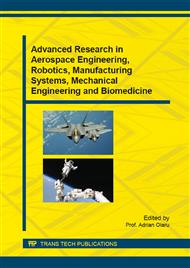p.45
p.50
p.57
p.63
p.75
p.80
p.85
p.92
p.99
Influence of Non-Stationary Thermal Field on the Hardness of Welded Samples
Abstract:
The ends of the welding beads are the site of certain non-conformities due to the transitory regime used for welding. In these start and end areas of the welding beads, the thermal field is propagated in non-stationary regime, as opposed to the portions from the middle of the welding bead where the heat is propagated in quasistationary regime.This paper proposes to present the influence of non-stationary thermal field from the welding ends on the hardness values performed in such critical areas, by comparing these values with the values of hardness performed on the middle portions of welding beads. A similarity comparison is made with the situation of the welding works performed within the reconditioning process by welding, when the welding works are of short length executed with multiple rows, were the thermal field is also propagated in non-stationary regime.
Info:
Periodical:
Pages:
75-79
Citation:
Online since:
November 2015
Authors:
Keywords:
Price:
Сopyright:
© 2015 Trans Tech Publications Ltd. All Rights Reserved
Share:
Citation:


